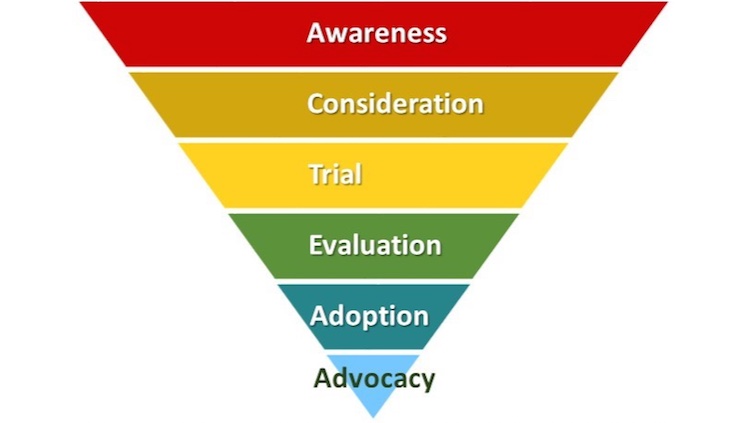More Devotees, Happy Devotees: The Seven Stages of ISKCON Membership
By Kripamoya Das | Jul 29, 2016

Material researched and presented by ISKCON Online.
The diagram above is of a generic ‘Sales Funnel’ or ‘Marketing Funnel’ used in the world of business for many years to show how a customer flows through stages from initial awareness of a product to being an enthusiastic advocate of the product. Every business wants enthusiastic advocates, and that’s why its important to keep a potential customer moving from one stage to the next, maintaining and developing their interest and commitment all the while. You’ll see from the ‘funnel’ shape that the number of people exposed to the advertising is far greater than the eventual number of ‘advocates,’ and in between there’s several stages at which its easy to lose the customer.
This general flow from vague awareness to advocacy is also true of missions such as ISKCON, too. Its also true that it takes a lot of awareness creation – thousands of man-hours of it – to bring just one person to the point of ‘Consideration,’ and then a lot of personal interaction to bring them to the point of ‘Adoption.’ And, like any other business, we can lose people along the way.
How many stages are there in bringing a person from vague awareness of ISKCON to active membership? You can describe it in any number of stages, and the diagram above has six, but I counted seven. Here they are, with two things that happen at every stage:
- Seeds – A. Vague awareness of ISKCON by indirect exposure through friends, family or media B. Developing an interest in spirituality.
- Contact – A. Further awareness of ISKCON by direct exposure through street chanting parties, book distribution and/or festivals. B. Interacting with ISKCON members through meetings, chatting online or reading a book.
- Considering – A. Exploring personal interests. B. Enquiring and Comparing.
- Transforming – A. Opening up to change. B. Awakening of faith.
- Adopting – A. Beginning the practises of bhakti. B. Making lifestyle changes.
- Commitment – A. Accepting the parampara. B. Embracing the ISKCON family.
- Advocacy – A. Compassionate sharing. B. Missionary spirit.
The stages are similar to those a consumer would go through in adopting a physical product. First there is hearing about the product through advertising and verbal testimony; examining the product and comparing it with other similar products, considering whether or not to become a customer; trying out the product, and finally becoming a happy customer and telling others about the product.
It may be argued that faith cannot be compared to a physical consumer item such as a can of beans, because it is ‘an unflinching trust in something sublime.’ It is typically arrived at after a long series of intellectual considerations, internal adjustments and spiritual practise, yet the comparisons with observable consumer patterns are not inaccurate.
A person is attracted to the notion of bhakti after hearing about it, examines the concepts involved, tests it by meeting others who have adopted it and then experiments with the daily practises. After finding some satisfaction the person then moves toward ‘advocacy’ of bhakti – the compassionate sharing of it with others.
As a spiritual movement dedicated to increasing its membership, ISKCON’s purpose can be helped greatly by its leading members ensuring that all the natural stages in the flow are complete, and that aspiring bhakti-yogis can easily make a transition from one stage to another. Each stage requires a different kind of engagement with the new member, ranging from the initial conversations and personal example, through teaching of the basic concepts and practises, through to pastoral care and encouraging guidance.
ISKCON’s book distribution is legendary and immense in proportion to the size of its membership. Probably no other organisation can claim more voluntary teams interacting with the public on a daily basis. As a sales force it is unmatched in the business world. The movement’s membership involvement is also funnel-shaped because of the large amount of advertising and initial public contact conducted by the organisation. Thousands buy books, and hundreds of thousands hear the street chanting, and then progressively smaller percentages go on to become involved practitioners and advocates. This is a normal pattern for an organisation, particularly one with a very active marketing division.
To take a person through seven stages you have to make sure they have all the experiences that will gently take them from one stage to the next. Each stage requires its own knowledge and expertise, and it is therefore required that we divide up the responsibilities involved in each stage and make sure that someone is carrying them out. To fully capitalise on all the efforts expended by book-sellers, street chanters and festival-makers, and to ensure that as many as possible process through all the stages – not becoming lost along the way – ISKCON could examine carefully the other levels of its outreach, especially the stages where more direct, personal teaching and guidance are required. ISKCON wants to attract new members as well as retain the existing ones. A fresh look at how we help people in the important stages of consideration and transformation would be helpful. It would also benefit our movement as a whole to examine why members leave us, at what stage, and whether any changes are required in order to better care for our existing members.















